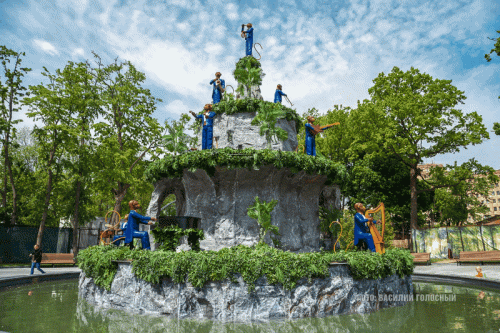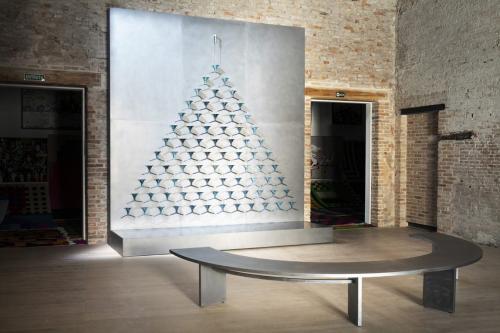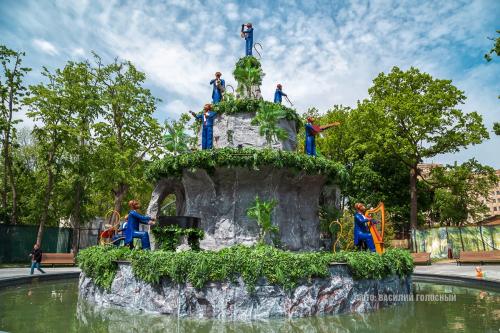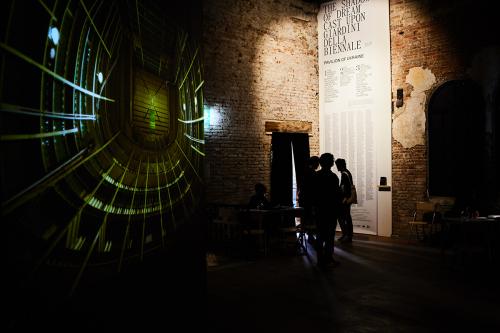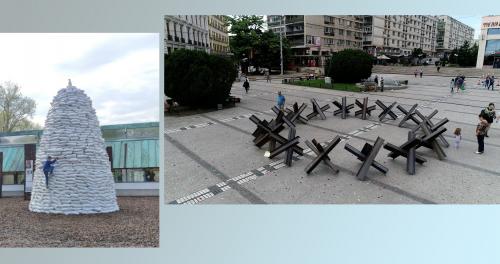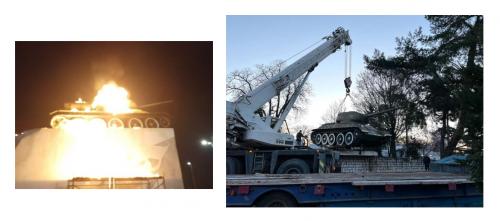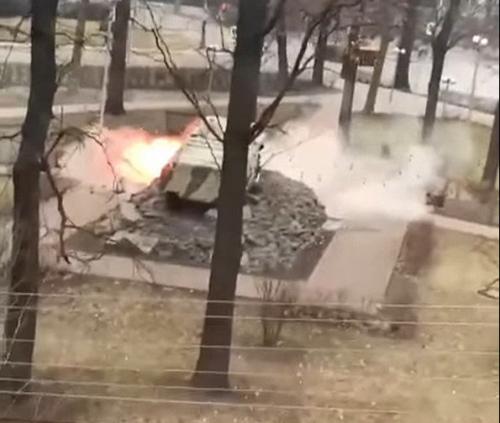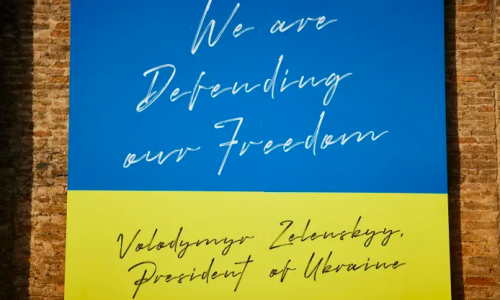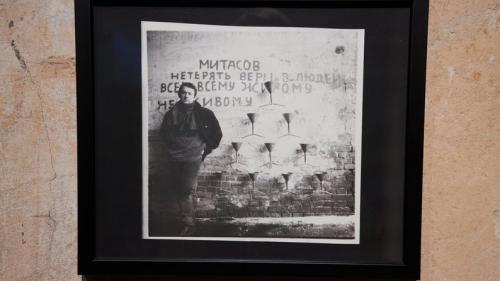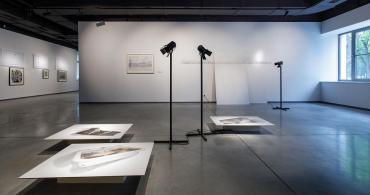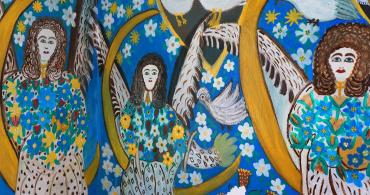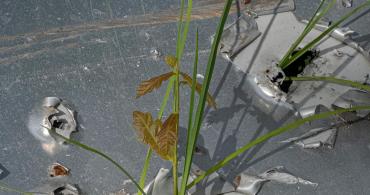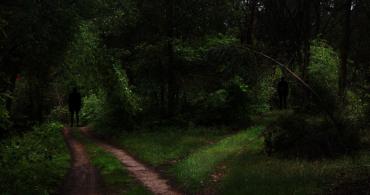Art and Reality: Making Sense of the War and Ukraine at the Future Biennials
Of course, art itself has neither such an opportunity nor responsibility. The world is changed via political means. But at the same time, artistic practices can draw attention to and directly interact with political contexts. Such art, which acquires even greater importance in wartime, helps people to see and reflect on the real situation around them. Art that says something about the world without the mediation of the professionalized art sphere embodies a strange sense of truth that is not found in confused gallery representations. And art that is capable of a political act can turn out to be prophetic. In this text, I will discuss several imaginative attempts to break out of the safe “zone of art” and confront it with various manifestations of reality. The consideration of the Ukrainian pavilion at the Venice Biennale, the parallel exhibition of the PinchukArtCenter, several works about the war, and the predictive direct action of a little-known art group can all be viewed through this lens.
For this analysis I will rely on the idea of art as optics. When art became contemporary, people experienced a new way of seeing and thinking about the world — and this way can be applied to almost anything in life. It does not need galleries, art centers, exhibitions, or biennials. When viewing certain art formats via these intermediaries, I see barriers to the real, scrims that can hide real processes and problems. However, in the Ukrainian art sphere, there is a small group of people who have managed to deal with these problems.
This text was not published in 2022 because I don’t feel I have any exclusive moral right to say what I say below. I am a part of the art environment that I criticize. But, in my opinion, it’s important to express it anyway. Here, it's as if a slightly different «I» is speaking in me – more courageous, decisive, and honest. At the same time, the ideas of this text are not utopian. It is quite possible to implement them, under certain conditions. They need change.
"Fountain of exhaustion" and "Fountain of multiplication"
Usually, the choice of the project for the Venice biennial is accompanied by heated discussions in Ukraine. However in 2022 the decision was unanimous: "Fountain of Exhaustion. High Water" by Pavlo Makov was chosen. The author's main practice lies in the field of visual art bordering on book illustration. However, he himself says that "Fountain" is an atypical work for him. It is noticeable how Makov's style — bourgeois stylization for antiquity, admiration for the aesthetics of scientific discoveries of the 15th century, and cartography — fits into the atmosphere of Venice. The team of curators of the Ukrainian pavilion also skillfully placed the layering of meanings into an international context: "Fountain of Exhaustion" by Pavlo Makov is a work about the depletion of earth's resources, alternating floods and droughts, re-evaluation of democracy, social practices, human relations with nature and the role of the artist in times of permanent changes". The project also touches on the topic of the coronavirus pandemic and, in general, "goes beyond the context of an industrial Eastern European city and becomes a general image of exhaustion at the cultural, economic and political levels." In the same material, the curators refer to sociologist Zygmunt Bauman's concept of "liquid world" and reference global warming, the consequences of which Venice is facing today. In general, the fountain of exhaustion is a convenient metaphor that can be interpreted in many ways. We can say that the "Fountain" is a metaphor for our war, which Russia is waging to exhaustion. But all this is just a skillful juggling of metaphors that lack specifics. This juggling (a sign of curatorial professionalism), aimed at adapting to the context of an international exhibition, entertains the viewer with the layering of illusory meanings without addressing real problems. Despite the lack of specifics, the conversation about the exhaustion of the world is more relevant than ever on many levels. However, a better candidate for "Fountain of Exhaustion" immediately comes to mind. Pavlo Makov came up with the idea for this project in 1995 within the framework of the UTOPIA cycle. The pavilion team emphasizes that the "Fountain" has never functioned as an actual fountain until its display in Venice. In the 1990s, the author attempted to install the piece in Kharkiv but wasn’t able to come to an agreement with the city’s authorities or even with various museum officials, due to both technical and conceptual obstacles. "I saw that society is unable to accept this work, unable to make a diagnosis for itself. I was asked: ‘Why the exhaustion? Maybe multiplication will be better?’", says Makov. Society's inability to accept and change reality, settling for dreams of a better future instead of actively working for one, is precisely what makes it impossible.
No breakthrough, no failure
"I would really like a breakthrough, but it seems that no one is ready for this breakthrough," Artist Leonid Voytsekhov in 2013.
"Not only is there no breakthrough, but there is no failure either!", A former member of the Open Group Stas Turina at the beginning of 2022.
The monkey fountain in Venice is a joke from a past life, but only half a joke. The serious half reminds me of Ukraine's previous project at the Biennale and raises a key question about the relationship between reality and art.
In 2019, “The Shadow of Dream* cast upon Giardini della Biennale” of the Open Group was a non-format project that violated the "professional rules" of the Biennale in order to focus on the reality of Ukraine. In it, the members of the group opposed the representation of Ukraine with personal projects and proposed their own: a flight of the famous Mriya plane (the largest in the world) over the Venetian gardens, with an imaginary "Ukrainian artistic community" on board in the form of a catalog with the names of 1143 artists. The implementation of the idea turned out to be weaker than the idea itself, but its critical instruction still speaks to me. The Open gGroup wanted to say, "Fuck you biennale", to question this "festival of marketable art" and to address local issues that always remain outside the scope of such a celebration. At the time, many opponents of "The Shadow", defending professionalism, derided this project as a shame for Ukraine. It’s time to confront the superficial dichotomy of shame and dignity with the question of the real and the need to make sense of it. Art that is capable of doing this was necessary even before the full-scale invasion, but now it is even more crucial.
Such art can express a certain truth about reality, moreover, it is capable of inspiring political action that directly affects reality.
And it doesn't matter if this reality is shameful or dignified. After all, the latter arises only if the former is understood. Without this type of art, all efforts to present Ukraine to the international community as a "normal European country" look like an attempt to prove it to oneself without entering into political life.
I must admit that by criticizing the "Fountain of Exhaustion" and supporting "The Shadow", I am actually criticizing the Biennale system as such. I can still only imagine the intersection of reality in art. It may seem that this is only a dream, similar to Leonid Voytsekhov's fantasy about the Niagara Fountain (an upside-down waterfall). However, the difference is that "Monkey Orchestra" really exists, and everything described below could really exist too if we entertained the possibility of a different set of rules in art.
Reflection of war in art
The Ukrainian pavilion at the 2022 Venice Biennale was not intended to be a breakthrough. Moreover, no one could foresee a large-scale war and start reflecting on it in advance. The curatorial team addressed this issue in a second manifesto released after the beginning of the war, where the "Fountain of Exhaustion" and the practice of Pavlo Makov are placed into a new context. Here again, like the Open Group, I would like to oppose the representation of Ukrainian art through personal projects. The curatorial manifesto concludes as follows: “From the very beginning, the view of Giorgio Morandi, who could talk about the whole world looking at it from the window of his studio, was important to Makov's practices. Today's question: can the world prevent the final exhaustion of humanity? Now you can answer it by looking through the windows of Ukrainian cities." But if you pay attention to the artists who stayed in Ukraine, joined the Armed Forces, or volunteered, it becomes clear that it is impossible to answer this question simply by looking out the window.
The team of the Ukrainian pavilion spoke about the new military reality in another exhibition, quickly organized in Venice called Piazza Ukraina. Its central work is an untitled installation by Dana Kosmina, a cone-shaped sculpture made of sandbags, which alludes to the protection of monuments in Ukraine. The work could make more of an impression outside the "territory of art" that viewers are usually prepared to engage in. The impact would be more meaningful for example if the Venetians suddenly saw their favorite monument surrounded by sandbags. In the public space, this work would not only display the value of Ukrainian cultural heritage but would also make clear the threat of Russian aggression to Europeans themselves, which they do not fully realize. A similar work by Nikita Kadan called "Moving Circle" was presented as part of Romanian Creative Week 2022. It consists of 16 anti-tank hedgehogs standing on Unity Square in the Romanian city of Iasi. Why exactly 16 hedgehogs, and not say, 12, like the stars on the flag of the European Union, is not clear. Despite being located in a public space, this work also performs a purely symbolic role. The objects in it, similar to Kosmina's work, are solely art objects, separated from their main purpose of blocking the movement of occupying tanks. If these hedgehogs were blocking a large street, preventing cars from passing, they would more clearly lay bare the danger of the Russian Federation.
Deoccupation of oneself
Of course, now we have to talk specifically about the war, about the external enemy. However, at the same time, it is important to pay attention to processes within Ukraine. Of course, now we have to talk specifically about the war, about the external enemy. However, at the same time, it is important to pay attention to processes within Ukraine. Namely, the demolition of monuments in the form of Soviet military machinery. And a special artwork, that resonated aptly with this process. After looking at art that is able to express the truth about the world as described above, it is time to move on to art that is capable of inciting political action that directly affects the world.
In 2019, a group of activists from Lviv with the kitsch name "Warriors of Good and Light" made a prophetic gesture. Three members of the group (Olexandr Andriyash, Yuriy Sydorenko, and Yaroslav Prykhodko) came to Chernihiv to perform a "Deoccupation" action. They threw Molotov cocktails into a Soviet tank displayed on a pedestal as "liberators from the workers of Chernihiv." The artists were immediately detained by locals and handed over to the police, without any thought as to what the action symbolized. This is how the group describes its idea:
"The act of political art "Deoccupation" (Desacralization) is directed against the hypocrisy and duplicity of the national politics of memory. According to the law on decommunization, Ukraine as a state does not recognize itself as the legal successor of the Soviet Union and does not bear responsibility for the crimes committed by it, motivating this by the fact that from 1917 to 1991 it was under the occupation of the communist totalitarian regime, and therefore is its victim. But on the other hand, we continue to honor the achievements, victories, and shrines of the occupier, both at the official and everyday level. Despite the fact that, according to international laws, the Russian Federation, unlike Ukraine, recognizes itself as the legal successor (and in fact, a follower) of the USSR. It follows that the tank in the square of the Ukrainian city is Russian. Not only is it a symbol of the occupier of the past, but also of the present."
Now, this pespective looks incredibly prescient. An official wave of demolition of tank-monuments to victory in the “Great Patriotic War” has already begun. Ukraine has canceled Soviet Victory Day and established Europe Day on May 9. We will now celebrate the victory over Nazism a day earlier, on May 8, 1945, when the Anti-Hitler Coalition signed the "Act of Unconditional Surrender". But in 2019, Ukraine sentenced the artists to 3 years of probation, and the prosecutor asked for 4 to 4.5 years of detention. The artistic community did not comment at all on the action, which was written about only by two media outlets — Graty and Nihilist. It is difficult to imagine such a response now.
On social media, you can find various proposals for redefining the memory of the Soviet period and the Second World War. Most of them are about Ukraine's appropriation of the victory over Nazism. Even President Zelenskyy stated on the occasion of May 9, 2022: "We are proud of our ancestors who, together with other peoples as part of the anti-Hitler coalition, defeated Nazism. And we will not allow anyone to annex this victory, we will not allow it to be appropriated." Obviously, if we want to make the victory over German Nazism our own, we must also take responsibility for the crimes of Soviet Ukraine and its complicity in the crimes of the Union. So, the Soviet period cannot be defined only as the occupation of Ukraine by the USSR.
Demonopolization of Ukrainian art
"Why exhaustion? Maybe multiplication will be better?", Pavlo Makov was asked about "Fountain". The question hidden in the prosecution of "Deoccupation" has a similar logic: "Why bear responsibility for the crimes of Soviet Ukraine? Maybe it's better to just celebrate the victory?". Such a reaction is a manifestation of cultural amnesia, an attempt to forget or reject the Soviet past, which needs to be acknowledged and dealt with. This past is still relevant for us. In particular, for the part of the Ukrainian artistic community that is dependent, like part of Ukraine, on one ever-present post-Soviet syndrome – the oligarchy. I’m specifically referring to the exhibition "This is Ukraine: Defending Freedom" by PinchukArtCenter, which opened in 2022 in Venice with the official participation of the Office of the President, parallel to the national pavilion where the "Fountain of Exhaustion" was presented.
For years, the Ministry of Culture collaborated with Pinchuk Art Center on official exhibitions for the biennale, testifying to Ukraine's inability to do this on its own. This year, even with a high-quality state project, the monopolist of the Ukrainian art market again attracted international attention. It is not surprising, because President Zelenskyy himself supported the idea of the exhibition and personally spoke at the opening via video link. The president's wife Olena Zelenska also addressed the audience, and her letter was read by the ambassador of Ukraine to Italy, Yaroslav Melnyk. The exposition, which includes contemporaries and classics of Ukrainian art, is represented by the works of the stars of the art scene, which is typical for PinchukArtCenter. Svyatoslav Vakarchuk and Tina Karol sang for them. Why did the president approve the oligarch's exhibition by his presence, but decided to stay quiet about the state pavilion?
Viktor Pinchuk and his PR project have previously raised many questions that the artistic community did not want to discuss. They just wanted access touse the oligarch's resources. If someone is not convinced by the execution of ex-president Kuchma's informational orders after the murder of journalist Georgy Gongadze, now there is a new, no less shameful detail in Pinchuk's biography. Do you remember the article by Timofey Sergeytsev in RIA Novosti "What Russia should do with Ukraine"? In it, he unfolds the large-scale plan of Putin's dictatorship, not shying away from direct calls for the murder of Ukrainian elites and ideological repression of citizens. According to the ruscist Sergeytsev, Ukraine needs to be "denazified", which certainly means de-Ukrainization and de-Europeanization. After all, he considers "Ukrainianism" to be an artificial identity of the population of the so-called "Malorossiya" and "Novorossiya", just an anti-Russian construct that "does not have its own civilized meaning" and obeys the West. It is clear to everyone that this propaganda can no longer be taken lightly. You can no longer not believe in it. So why does the artistic community, as well as the Ukrainian state, continue to treat this man-eater's colleagues not seriously?
Sergeytsev has been present in Ukrainian politics since 1999 when he worked in Kuchma's headquarters together with Russian political technologist Dmytro Kulikov. Guess who hired a Russian propagandist for Kuchma — Viktor Pinchuk. Pinchuk then cooperated with Andrii Derkach, a member of the pro-Yanukovych “Trudovaya Ukraina” party, a graduate of the FSB Academy of the Russian Federation, and "a Russian spy with more than 10 years of experience," according to the US sanctions list. It is not surprising that in 2004 Sergeytsev worked for the “Party of Regions”, where he took a direct part in the creation of the Kremlin-backed concept of "three Ukraines". In 2012, Pinchuk hired him again for the election campaign of Yakov Bezbach, a member of the “Party of Regions” and a former employee of Interpipe. Tymofiy Sergeytsev also directly advised Pinchuk's businesses — he was responsible for the reorganization of the Interpipe group and the ICTV channel. Yaroslav Bozhko, the author of an already deleted column filled with details about the links between Pinchuk and Sergeytsev, asks a logical question: "In 2018, Pinchuk was briefly deprived of the opportunity to export pipes to the Russian Federation, and almost went bankrupt. What did he promise in return for access?"
Unfortunately, I anticipate a counter-question: "Why does an "oligarch" have to take responsibility for his cooperation with the information officer of the FSB?" Maybe a "patron" who has done a lot for modern art is better?". Pinchuk certainly has heavily impacted modern Ukrainian art, but for what purpose? Purely due to wealth illegally privatized in the 1990s, he had and still has access to the superstars of the art world. There was an opportunity to monopolize the then-non-existent Ukrainian art market. So, the state still cooperates with the oligarchic organization and the artistic community does not see a way out of this state, because it is not ready to engage in cultural politics. They can tell me: "Viktor Mykhailovych is now helping Ukraine." And this may even be true, but it hides one simple fact: for everything described and not described above, Pinchuk never bore any responsibility — criminal, political, or reputational. These answers, therefore, will only be a continuation of our cultural amnesia.
It is important to note that artists are not the source of the problem. These people are responsible for their own choices, but it is clear: Being involved with PinchukArtCenter is the most effective way to become a successful artist in modern Ukraine. This will continue to be the case until we have equally strong state, corporate, or private (non-oligarchic) platforms. When they will appear depends not on the artists themselves but primarily on the readiness of the state to promote quality alternatives and generally place value on modern art. At the same time, citizens are the state, and artists are agents of cultural policy. Therefore, in order to break Pinchuk's monopoly, they (we) will have to make their case to the state.
* * *
In 2010, Pavlo Makov was interviewed by Art Ukraine magazine. Under the eloquent title "Reality is always stronger than any hoax," the author of "Fountain of Exhaustion" said:
"... no art will surpass reality and make a stronger impression on the psyche than the pyramid of children's pots in Mauthausen... Art has a zone where it works. I understood this well in the case of Mitasov (Oleg Mitasov is a mentally ill urban legend from Kharkiv, who in the 90s painted every centimeter of his apartment with words and texts. — ed.). What I saw in his home impressed me in a way that no artistic provocation had!... I am simply transferring it to another context where it will be of interest not only to doctors. Visually, it is much stronger and scarier than any provocation of my colleagues. But the man paid for it with his life. Which artist is ready to pay such a price for what he does?"
Contemporary art began when it began to expose the conditions of its own production. This is how the real outside the "zone of art" was revealed, and this later enabled its politicization. Without addressing this political reality, modern art is only capable of secondary representations. After all, they are just works. This is what artists choose when they display at PinchukArtCenter. If no art can transcend reality, why do artists think they can express their truth about the world while ignoring the reality of Pinchuk's name and reputation? And if they don't think so, are they willing to trade their career success and exceptional status for the anti-oligarchic reform of the "art zone" and Ukraine in general? This question assumes that what is being paid for has value in and of itself. And if this is not the case for PinchukArtCentre artists, then the freedom they are trying to defend at the "Defending Freedom'' exhibition will continue to be tainted by cultural amnesia and the oligarchy.
* The autor thanks to Misha Bogachov and Liza Korniychuk for detailed editing, and Mykhailo Zyatin and Larisa Venediktova for discussing some ideas of this text.

